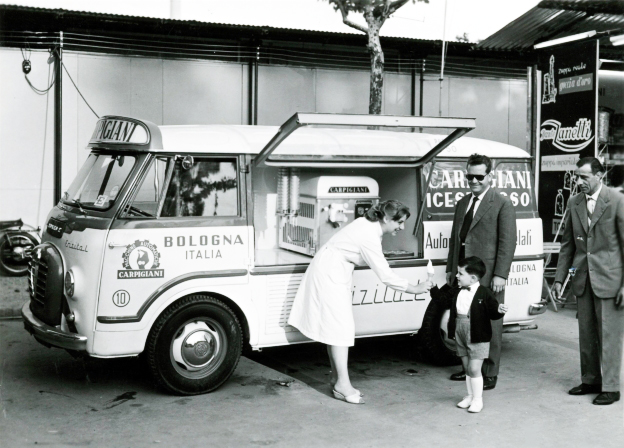As everyone prepares for the Fourth of July celebrations, one of the staples of the holiday will surely be ice cream for dessert. Rather than simply picking up something from the supermarket, consider stepping up to the bold and delicious flavor of gelato.
Italian gelato is considered by many to be one of the world’s most perfect creation. Rich, creamy and bursting with flavors of fresh fruit, nuts, chocolate and spices, gelato is a tasty delight from the very first taste! Sun-filled days and eating gelato are memories imprinted on virtually every Italian’s mind. As a summer long treat, Italians head to the local gelateria to choose from a large variety of flavors. From the vantage point of the 21st century, it may seem incredible that a form of an iced delight could have existed before the modern luxury of freezers, but it did.
The word gelato literally means frozen, but is used to refer to ice cream in Italy. For centuries, Sicilians used the snow from Mount Etna to cool drinks and freeze desserts. Based on historical records, it is believed that in ancient Roman times, foot runners brought snow from Etna to Taormina and Catania to be flavored with nuts, berries and honey. At the time, these sweet treats were enjoyed only by aristocrats. In the ninth century, when Sicilians were introduced to sugar cane, it revolutionized Sicilian cooking. They began to sweeten their drinks, both hot and cold, with this new product.
Sicilian passion for iced desserts continued unabated for centuries as they continued to experiment with new flavors and textures. Centuries passed before dairy was added to iced desserts to create gelato. The use of milk is what makes gelato different from ice cream. Some might consider it to be a slight variation, but it is one that makes an enormous difference in the flavor and texture. The use of milk, especially skim milk, gives gelato a much lower fat content and allows the flavors to be seductively prominent. Gelato has less air whipped into it than ice cream which makes it denser, as well as smoother and softer in consistency.
Although it is difficult to pinpoint the exact date when gelato was first created on the island, history points to Sicilian fisherman Francesco Procopio dei Coltelli as the individual who perfected the treat while in Florence and notes that he was the first maker of gelato for public consumption. Francesco traveled to Paris in 1660 to open Café Procope and took with him a new and improved invention; a gelato making machine. Signor Procopio had been experimenting with using salt to lower the temperature of his icy concoction and had now created a way to sell his fruit-based gelato, also known as sorbetto, to the public for the first time. His cool treat, which had previously only been known to royalty, became a huge success.
By the late 1600s, Sicilian iced delights were famous throughout Italy. The mixtures of fruit and ice (granite), sorbetti and sorbetti con crema (the predecessor to gelato as we know it today) were gradually becoming a favored treat among all of the classes of Italians. Nowhere was this more evident than in Sicily, where the creation and eating of gelato was taken very seriously at all levels of society. Much was written about Sicilian’s passion for ices, a term used interchangeably with gelato. King Vittorio Amadeo II even referred to Sicilian legislators as, “an ice cream and sorbet parliament” in the 1700s. He may have been referring to parliament’s decision in 1774 to send troops to Etna to procure snow, when the supply in Palermo ran out. William Irvine, an English gentleman visiting Sicily in the 1800s noted that even the peasants who walked the streets in rags, still made sure they had coins to spend in the ice shop.
Over the centuries, Sicilian gelato makers perfected the technique for creating their own distinct gelati. The art of traditional gelato making was passed down from father to son. The art was improved through the 20th century, when gelato makers began to emigrate and introduce gelato to other cultures.
Sicilian gelato is different from that found in the rest of Italy because it rarely contains eggs or cream. The base is crema rinforzata, a sweet pudding of milk thickened with either corn or rice starch. This makes it a lighter version than gelato produced on the mainland. Sicilians also have a number of unusual ways they serve and eat their ice cream. Many will have a brioche filled with gelato for breakfast. The gelato filling the brioche is called spongato and has a smooth texture because it is not chilled long enough to completely harden it. Another gelato treat is pezzo duro, a slice of a solidly frozen gelato, which can vary by region. In Palermo, they serve rectangular portions of lemon and strawberry sorbetti covered with candied citron, while in Catania you can order a misto Umberto, a chocolate ice cream exterior with pistachio and vanilla gelato inside, layered with sponge cake and candied cherries. Gelato is also used as a filling for the always popular cannoli.
Sicilian gelato is likely the best you’ll find in Italy, with its abundance of fresh fruit and quality ingredients. Favorite flavors range from pistachio and nocciola (hazelnut) to gelsomino (from the jasmine flower) to gelato made with gelsi (mulberry), fragola (strawberry) and zuppa inglese (rum). Other enticing flavors are ricotta and cannella (cinnamon) and most recently, cassata.
Sicilian skill at making gelato and their enjoyment of the results is evident inside Sicilian gelaterie at any time of day or night. Many of the gelaterie in the larger cities offer a wide variety of flavors to serve both the Sicilians and the tourists who flock to the island. Savoring a Sicilian gelato is an event, whether enjoyed it as a secret solitary treat or shared with a group of friends with a lively debate on whose pick is the best. The answer? They all are! For the Fourth, try your hand at these delicious gelato recipes.
Pistachio Gelato
Pistachio gelato is the benchmark by which many gelaterie are judged. You can tell at a glance if an artificial base has been used, just by the color. If the gelato maker is using real pistachio nuts, the color will be an almost drab green.
Ingredients
- 1 cup (6 ounces) shelled pistachios, lightly toasted (about 12 ounces in the shell)
- 3 cups whole milk
- 3/4 cup sugar
Preparation
In a food processor, coarsely chop the pistachios, reserving a few whole ones for garnish.
In a medium saucepan, combine the milk and sugar. Cook over medium heat, stirring until the sugar is dissolved and bubbles form around the edges of the pan. Remove from heat, add the pistachios, cool, cover and refrigerate overnight.
Strain the milk mixture through a fine-meshed sieve, pressing on the nuts with the back of a large spoon to get as much liquid from the nuts as possible. Transfer to an ice cream maker and freeze according to the manufacturer’s instructions.
Stracciatella Gelato
Stracciatella Gelato might resemble chocolate chip ice cream at first glance, but it is completely different. Instead of the chips and sometimes chunks you find in an American product, Stracciattella has fine bits of chocolate throughout, which results in a smooth texture with just the slightest crunch in every bite.
Ingredients
- 2 cups whole milk
- 1 vanilla bean, split lengthwise
- 3/4 cup sugar
- 5 large egg yolks
- ½ cup chilled heavy whipping cream
- 1/3 cup bittersweet chocolate chips
- 2 tsp vegetable oil
- pinch of coarse salt
Preparation
Place milk in a medium saucepan. Scrape in seeds from vanilla bean; add bean. Bring to a simmer, whisking often. Whisk sugar, yolks and salt in a medium bowl until well blended, about one minute. Gradually whisk hot milk mixture into yolk mixture. Return to saucepan; stir over medium-low heat until custards thickens and a thermometer registers 170°-175°, about five minutes (do not boil). Strain into a medium bowl. Stir in cream. Chill custard until cold, at least two hours.
Stir in chocolate and oil in a small saucepan over low heat until melted; let cool. Process custard in an ice cream maker according to manufacturer’s instructions. Slowly add all but one teaspoon melted chocolate during the last 30 seconds of churning (chocolate will form small chips). Transfer to a bowl. Drizzle remaining chocolate over gelato in zigzag lines. Serve immediately.
Chocolate-Hazelnut Gelato
Ingredients
- 2 cups whole milk
- 1 cup heavy cream
- ½ cup sugar, plus 1/4 cup
- 4 egg yolks
- ½ tsp. vanilla extract
- ½ cup chocolate-hazelnut spread
- ½ cup toasted hazelnuts, crushed, for garnish
Preparation
In a saucepan combine the milk, cream and ½ cup sugar over medium heat. Cook until the sugar dissolves, about 5 minutes.
Meanwhile, in a medium bowl whip the egg yolks with the remaining sugar using an electric mixer until the eggs have become thick and pale yellow, about 4 minutes. Pour ½ cup of the warm milk and cream mixture into the egg mixture and stir. Add this mixture back into the saucepan. Cook over very low heat, stirring constantly, until the mixture becomes thick enough to coat the back of a wooden spoon, 7 to 10 minutes.
Place a strainer over a medium bowl and pour the warm custard mixture through the strainer. Stir in the vanilla and hazelnut spread until it dissolves. Chill mixture completely before pouring into an ice cream maker and follow manufacturer’s instructions to freeze. To serve, scoop gelato into serving bowls and top with hazelnuts.





